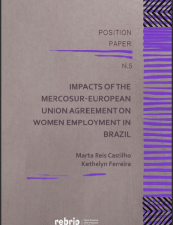Menu

Impacts of the Mercosur-European Union agreement on women employment in Brazil
Gênero
1Introduction
The analysis of socio-economic impacts of international trade has for a long time been considered neutral with regard to gender inequality; in other words, the effects of changes in the level or type of commercial integration between countries were to impact women and men equally (López, Muñoz and Cáceres, 2019). In the last two decades, there has been progressive dissemination of the perception that such neutrality does not exist as a result of men and women occupying diverse paid and unpaid job positions (Fontana, 2009). These differences can, furthermore, impact countries with regard to commercial performance and competitiveness (UNCTAD, 2017; Zarrilli, 2017). The economy, in other words, is a structure with gender issues. Gender relations are formed and conditioned according to the context in which social relations are included, originating stereotypes such as work division according to gender and vertical or horizontal[1] segregation (Ridgeway and Correll, 2004).
Based on this assumption, the literature often questions whether trade liberalization contributes towards reducing inequalities between women and men or reinforces them. This questioning has partly to do with the characteristics of jobs associated to exports and imports in relation to the total labor market in an economic setting. Indeed, according to evidence shown by Fontana (2009), the specificities of each country will play an essential role regarding the answers given to these questions. In other words, factors such as institutions in the labor market, the country’s socio-economic characteristics and the level of access to information and the markets have a strong influence in determining the results of trade over women. Additionally, the volume and profile of the job associated to trade differ according to commercial partners, especially in the case of countries with different types of geographic and sectorial expertise, as is the case of Brazil.
In this study, we seek to assess the impact of the European Union-Mercosur agreement on the jobs of Brazilian women. This agreement, whose signature dragged on for 20 years due to diverging interests between the two blocks, was finally signed at the end of President Macri’s term with the approval of the Brazilian President in 2019. The agreement follows the broad and comprehensive trend of the agreements that the EU has latterly signed and makes Mercosur countries commit to non-commercial disciplines and themes which have not thus far been part of the multilateral and bilateral agreements signed by the block – notably intellectual property and government procurement. With regard to trade liberalization, the agreement anticipates a strong tariff reduction for Mercosur industrial products and a more moderate liberalization for the European agricultural product market, as a result of timeframes and certain non-tariff barriers being maintained. For the Brazilian industry, particularly, the increase in competition with an industry as highly competitive as the European, due to trade liberalization and adherence to other disciplines can significantly impact domestic national production and jobs associated to it (Sarti and Castilho, 2021).
It is worth highlighting that we recognize that this “non neutrality” of economic phenomena, especially with regard to foreign trade, is not restricted to gender differences: the effects of changes in economic policies and conditions do not affect the various individuals with differing forms of integration in society in the same way, such as people of different socio-economic strata, different color or race, different sexual orientation or different gender identities.[2] In this regard, Azar, Espino and Salvador (2009) state that despite gender being an explanatory variable of social inequalities, it is no more than a social construction, such as race, ethnicity, class and sexuality, which are also socially constructed categories, which intersect with gender and contribute towards determining the position of individuals in society. Besides these differences, in the women’s group, level of education, age, having or not children and their ages, in addition to the many obligations imposed in their homes and communities, they also influence their integration into the job market (Fontana, 2009).
It is always worth remembering that although the present study focuses on the labor market which pays wages, the impacts of a trade agreement are not restricted to it. According to Fontana (2020), changes in trade policies can affect the population through the following channels: employment, consumption and public provision. In the first channel, it is considered that policies will influence expansion or contraction of the different sectors and may change the demand for workers within them. In the second channel, it is understood that relative price and goods supply may also be subject to change. Finally, in the third channel, the idea is that the social services offered, as well as their quality, can change.
The importance of recognizing these channels exists because, as pointed out by Azar, Espino and Salvador (2009): restricting the analysis of gender relations and trade exclusively through the links between trade and the labor market ends up ignoring other factors and aspects outside the job market, but which contribute to inequalities in the realm of work itself. This is the case of the responsibilities assigned to women in the unpaid sphere of the economy and are reflected as disadvantages with regard to insertion into the job market, and even more in relation to wealth distribution, access to public assets and to the realms of power.
Regardless, however, of the different transmission channels, “the differences between men and women, whatever way in which they are integrated in society (work factor suppliers, consumers etc.)” (Castilho, 2010, p. 224), result in changes to trade regulation – such as regional and multilateral agreements – affecting women’s lives differently.
Although both economic theory and the analysis of concrete phenomena and policies insist on gender neutrality, the existence of different economic and cultural mechanisms result in women having to face different forms of discrimination in the different economic loci. The most evident is the labor market, where discrimination is visible and measurable via wage difference or occupation of leading positions, for example. For that reason, it will always be at the core of our analysis. There are, however, other loci as, for example, the one in which society’s reproductive tasks are carried out, where the role of women is very well socially defined in relation to that of men.
On account of the many discrimination mechanisms that exist, economic phenomena impact women’s lives differently. This is no different in the case of foreign trade – and consequently, trade agreements. The most evident connection between trade and gender happens, indeed, within the paid labor market. Changes in the flow structure of international trade can impact jobs, and due to their gender-based segmentation, end up affecting men and women differently. This is due to the fact that some sectors are more intensive in terms of male or female labor, or alternatively, of wage differences existing between women and men. The connection between labor market and trade can also happen in the opposite direction, which is: lower wages usually paid to women can be a source of competition – a spurious one, as Fajnzilber (1988) would say – and benefit countries whose specialization is concentrated in highly “female-type” sectors. (UNCTAD, 2014, Sipelman; Busse, 2005).
Unpaid work can also be affected by the progress of international trade, be it due to changes in the paid job market itself (and here the relation can happen in the two aforementioned directions), or due to changes in access to imported goods or services, also, in a regulatory environment capable of influencing the availability of public care services. Indeed, time allocation for men and women between paid and unpaid work and leisure may be influenced by changes in relative price for goods and services and paid work conditions (also potentially affected by international trade). With a difference in consumer baskets, price changes have different impacts on the purchasing power of both groups. There is evidently intersectionality of this aspect with the social classes in which they are found.
Beyond these specific connection/communication/relation mechanisms between trade and gender, the adoption of a certain trade policy direction is normally included within a broader economic policy direction. The trade liberalization process is normally associated to the implementation of so-called structural reforms, who have a decreasing State as one of their main objectives and motivations, including processes of privatization, deregulation and the reduction of State investment. According to Bidegain (2009), “Trade liberalization is part of a structural adjustment process which affects the rendering of services within the scope of the economy of care, restricting access to them for large sectors of the population, mainly those on low income” (p. 10, our translation). In this regard, some direct effects of trade liberalization can be increased through the adoption of policy packages employed to reinforce a liberal orientation. In Brazil, for example, trade liberalization in the 1990’s was contained within the adoption of a set of neoliberal policies aimed at reducing State participation in the economy.[3]
Finally, international trade was still able to influence the lives of women through the effect it can cause on economic growth and poverty.[4] Although the relation between trade and growth is not clearly demonstrated in the empirical literature (see Rodríguez and Rodrik, 2000), if it exists, it will somehow influence women’s lives, whether through income, through work opportunities, poverty reduction or consumer opportunities.
In order to analyze the prospects of the Mercosur-EU agreement for women with emphasis on employment, this study is organized into four sections, after this introduction. In the second section, a brief trade profile between Brazil and the European Union is presented. In the third, a few observations are made with regard to recent or ongoing changes in the female job market in Brazil, which somehow contribute to gender inequalities and make the situation for female employment in Brazil more delicate on the eve of the agreement being implemented. The fourth session is dedicated to presenting and assessing the volume and profile of female employment associated to Brazil-EU trade, based on an estimate of the work content contained in exports and imports, as well as an analysis of the quality of female employment associated to trade through an index that synthesizes some of the features of female employment. The final session points to the prospects of the agreement for female employment in Brazil and presents additional considerations about the prospects of the agreement according to a female point of view. It is worth highlighting that this text consists of a reduced version of the study of the same name.
[1] Vertical segregation refers to the difficulty that women have to rise in the ranks and occupy positions associated to decision-making. Horizontal segregation, in turn, refers to the fact of women staying in specific economic sectors and certain types of job positions (ILO-UNDP, 2019, apud Barafani and Verna, 2020).
[2] On this matter, Oliveira et al. (2021), for example, point out that an overlap of discriminating attitudes associated to these many social bookmarks takes place, and this overlap ultimately helps to increase the hierarchization imposed by gender division in the workplace.
[3] As an example, see the study on the impact of water privatization on women in the city of Manaus (Equit, 2013).
[4] As pointed out by Cagatay (2005), one of the arguments that has been used in favor of trade liberalization is that trade expansion has “equalizing” effects, from a gender point of view, by contributing to higher economic growth rates and increasing the level of competition among economies.

